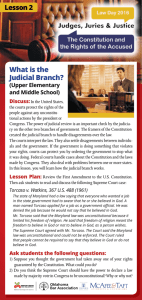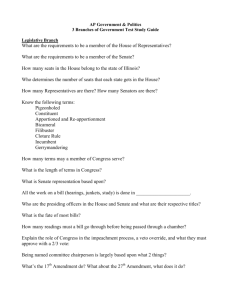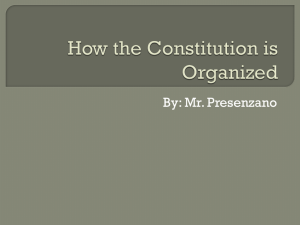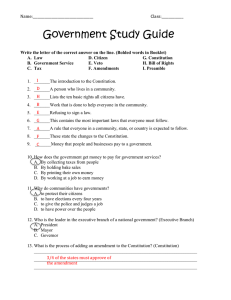Judicial -- Powers and Limits
advertisement
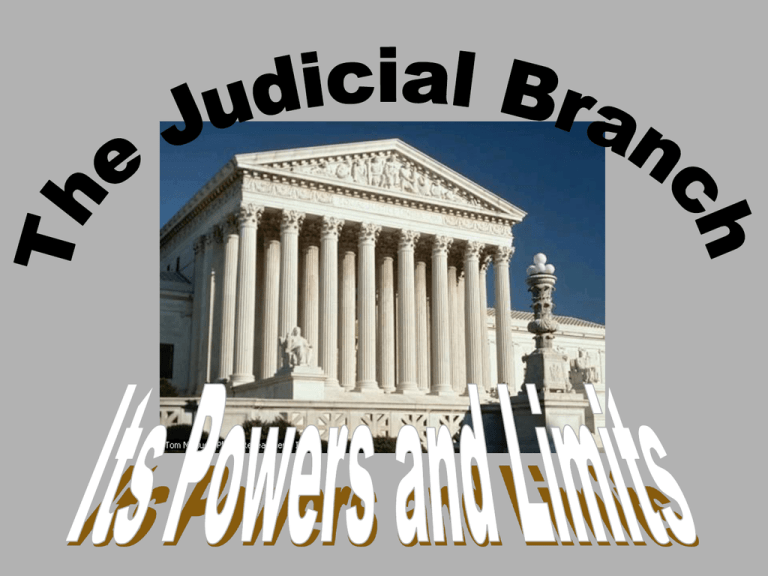
In the Constitution Section 1. The Judicial Power of the United States, shall be vested in one supreme Court, and in such inferior courts as the Congress may from time to time ordain and establish. What does that mean?? The Constitution creates only the Supreme Court of the United States. It gives the Congress the power to establish other lower, federal courts. In the Constitution- Section 1 Cont’d • The Judges, both of the supreme and inferior Courts, shall hold their Offices during good Behavior, and shall, at stated Times, receive for their Services, a Comprehension, which shall not be diminished during their Continuance in Office. • “…during good Behavior” a.k.a. life Current Supreme Court Early History Early in the life of the United States, the Supreme Court had little true power. It heard very few cases each year and was the weakest of the three branches of government. Early History In the early 1800’s, however, the court’s power increased because of Chief Justice John Marshall. Early History In 1803, the Supreme Court heard Marbury v. Madison. In this case, the Court ruled that a certain law was unconstitutional. This meant that the law violated the Constitution and was invalid. Judicial Review This power became known as the power of “judicial review.” Judicial Review is the power to overturn any law or executive order which the Supreme Court decides is in conflict with the Constitution. Judicial Review The Supreme Court’s primary power is to limit the power of the other two branches by declaring laws and executive orders unconstitutional. Limits on the Legislature The Supreme Court ruled a federal law involving federal income tax was unconstitutional. Limits on the Legislature In 1894 Congress passed a law for a federal income tax. In 1895, however, the Supreme Court ruled that law unconstitutional. The income tax law was removed. Limits on the Executive Branch President Harry Truman issued an executive order that the Supreme Court declared unconstitutional. Limits on the Executive In 1952 America was involved in the Korean War, and Steel workers threatened to go on strike. Truman issued an executive order to take over the mills and keep them running. The owners sued. The Supreme Court ruled that Truman did not have that authority, making the order unconstitutional. Executive Limits on the Court The President appoints justices to the Supreme Court. Justices serve until retirement or death which gives the president great power in swaying the direction of the Supreme Court if a seat becomes vacant. Legislative Limits on the Court Congress has a number of ways to limit the Judicial Branch: - creates the federal court system. - decides jurisdiction of courts. - provides money for courts. - can impeach and remove justices. - Senate approves Presidential nominees. Legislative Limits on the Court Since the Supreme Court’s decisions are based on their interpretation of the Constitution, another way to limit its power is to change the Constitution. Amendment Process The Congress may begin the amendment process. If both houses pass a proposed amendment with a 2/3 majority vote then the proposal goes to the states. 3/4’s of all states must then ratify an amendment (38/50). Limits on the Legislature To establish a federal income tax, Congress had to start the amendment process to change the Constitution. By 1913, the 16th Amendment was passed which amended the Constitution to allow the income tax. • How do cases get heard by the Supreme Court? • Most cases are heard as an appeal (appellate jurisdiction) • So, a lower court (either state or federal courts) hear that case first. The Supreme Court hears MOST of its cases on appeal
